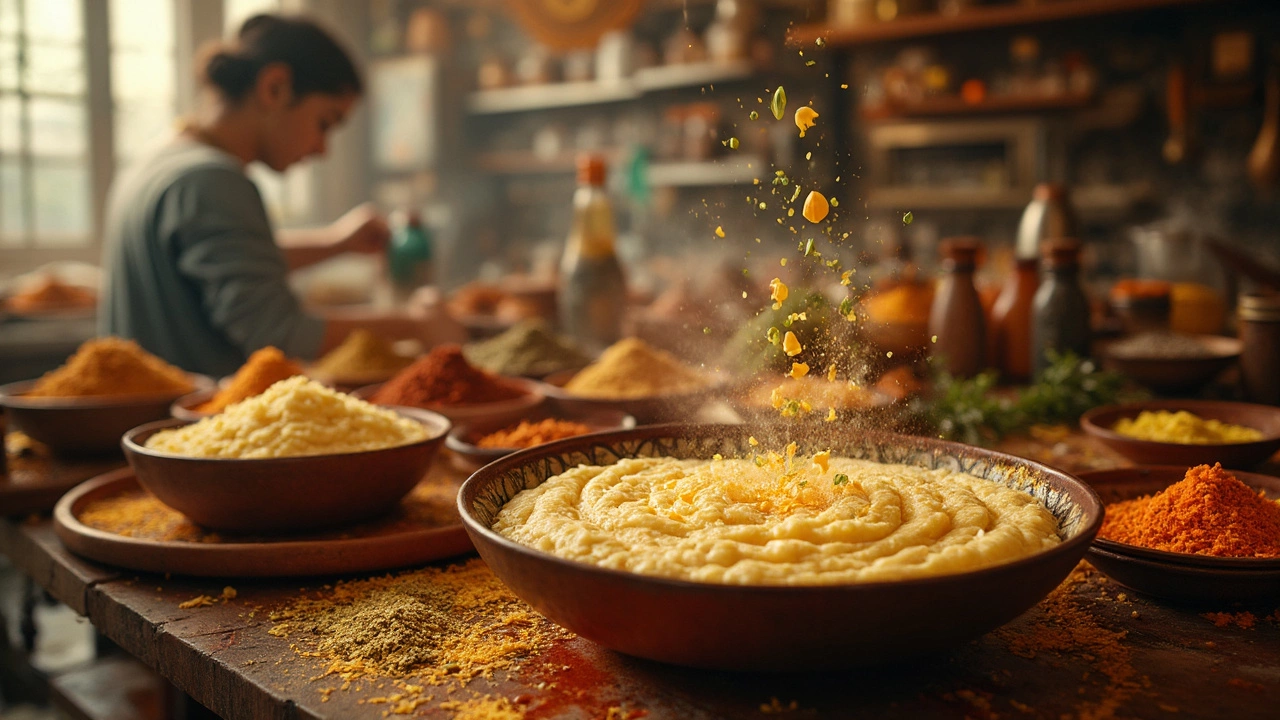Quick Tips to Ferment Dosa Batter Effectively
 Feb, 11 2025
Feb, 11 2025
If you've ever tried making dosas, you know that getting the batter to ferment just right is crucial. But, let's face it, waiting around isn't always an option when you're craving those delicious crispy delights. So, what's the trick to speeding up the process?
First off, understanding the basics of fermentation is key. It's all about the good bacteria doing their thing. The right mix of rice and urad dal sets the stage, but did you know that adding a touch of fenugreek can boost fermentation? Yep, these little seeds are like magical catalysts.
Getting the temperature right is another game-changer. Ideally, your batter should be kept in a warm spot. If it’s chilly, wrap the bowl in a blanket or place it in the oven with just the light on. Simple, right?
- Understanding Fermentation Basics
- Using the Right Rice and Lentils
- The Role of Fenugreek Seeds
- Controlling Temperature for Fast Fermentation
- Batter Consistency and Its Impact
- Additional Tips to Speed Up Fermentation
Understanding Fermentation Basics
Diving into the world of dosa fermentation, it's all about letting nature do its magic through tiny microorganisms. Yeast and lactic acid bacteria are your friends here. They're the unseen superheroes that work hard to give you that perfect bowl of bubbly batter.
So why does this matter? These microbes break down complex carbohydrates into simpler sugars, creating those necessary gases and proteins. This is what gives dosa batter its fluffy texture and tangy flavor—exactly what you're aiming for in those crispy dosas.
Temperature's Role
Temperature is a big player in this game. A warm environment speeds up the whole process. Ideally, keep the batter at around 30°C (86°F). If you're living in colder areas, using a warm spot in your kitchen makes a huge difference.
Time Isn't Everything
While traditional methods take about 8 to 12 hours, the actual time needed for quick ferment tips can vary. Factors like room temperature, quality of ingredients, and even the type of water used can all play a role.
Several folks improvise by placing the batter in an electric blanket or a switched-off oven with just the bulb on to maintain warmth. Ingenious, right?
Probiotic Boosters
Sometimes, a little boost helps. Adding a spoonful of yogurt, which is rich in existing cultures, can jumpstart fermentation. A pinch of sugar can also help, as it feeds the microorganisms.
Visual and Sensory Cues
How do you know your batter's ready? Look for a slight rise in volume, an increase in bubbles, and a characteristic slightly sour smell. These are your signals that the batter is ready to spread onto that hot griddle.
Using the Right Rice and Lentils
Choosing the right ingredients—the perfect combo of rice and lentils—can make your dosa batter ferment faster and better. It's the foundation of successful dosa-making. Let's break it down.
Picking the Rice
Start with a good quality short-grain rice like Sona Masuri or Ponni. These types absorb water well, which helps in creating a smooth batter. Avoid long-grain rice like Basmati—it just doesn't do the job here.
Choosing Your Lentils
Now, let's talk about urad dal, which is the lentil used in dosa batter. Go for split or whole skinless urad dal; both work, but the split is often easier to work with. A 4:1 or 3:1 ratio of rice to urad dal is pretty standard.
Why Freshness Matters
Believe it or not, the freshness of your ingredients plays a significant role. Fresher lentils and rice often ferment better and faster. So, always check the packaging date when buying or, even better, source them from a local market where turnover is high.
Creaming It Right
Once you've soaked your rice and lentils, grind them into a smooth paste. The smoother your paste, the better your chances of quick fermentation. Aim for a creamy consistency that isn't too thin—just like pancake batter.
Optional Extras
Some folks also add a bit of cooked rice to enhance the fermentation process. Another trick? Throw in a handful of poha (flattened rice) with the soaking rice; it helps absorb more moisture!
With these ingredient choices and tweaks, you’re well on your way to quick fermentation and, more importantly, the best dosas in town.
The Role of Fenugreek Seeds
So, you might be wondering what's the deal with adding fenugreek seeds to your dosa batter. Turns out, these tiny seeds are more than just a flavor boost. They play a huge role in the fermentation process.
Why Fenugreek?
For starters, fenugreek seeds have natural compounds that enhance fermentation. They contain proteins and other nutrients that encourage the growth of the good bacteria essential for fermenting your dosa batter. And, hey, good bacteria mean tastier dosas!
How to Use Them
It's pretty simple. When you soak your rice and urad dal, toss in a small teaspoon of fenugreek seeds. They don't need to be pre-treated or anything fancy. Just let them soak with the rest of your ingredients. Once you grind all the components, the seeds will break down and blend into the batter seamlessly.
- Use about 1 teaspoon of fenugreek seeds for every 2 cups of rice.
- Soak them together with your rice and lentils for at least 6 hours.
- Grind everything to a smooth consistency.
Fun Fact
An interesting statistic popped up in a local cooking journal last year. It said that batter with fenugreek ferments up to 20% faster than when it's left out! So, for those days you're in a hurry, these little seeds are your best friends.
Besides accelerating fermentation, fenugreek adds to the nutritional value. It's known for its anti-inflammatory properties and also helps in managing blood sugar levels. Double bonus!

Controlling Temperature for Fast Fermentation
When it comes to fermenting dosa batter, temperature plays a massive role. The warmer, the better - in most cases. But let's break it down a bit, so you can be sure your batter ferments effectively without going haywire.
Why Temperature Matters
Temperature is like the secret ingredient in dosa fermentation. Too cold, and those bacteria are sluggish. Too hot, and you risk spoiling the batter. The sweet spot? Around 30°C (or 86°F). That's when the magic really happens.
Clever Ways to Keep Things Warm
So, how do you keep the batter in that perfect range? Here are a few tricks:
- Wrap it up: Use a thick blanket or towel to insulate the bowl. This is especially handy in colder climates.
- Oven magic: Just pop it in the oven with the light on. No need to turn on the heat – the light creates a cozy environment.
- Warm water bath: Place your batter bowl inside a bigger bowl or container filled with warm water. This gently raises the temperature around the batter.
A Quick Note on Summer and Winter
Seasonal changes can impact your batter fermentation. In summer, you might not have to do much, while in winter, you need to get creative. But with practice, you'll find what works best for your location and kitchen setup.
Monitoring for Perfection
If you’ve got a thermometer, use it. It takes the guesswork out. But if not, just keep a close eye on how the batter is progressing. A good indication that it's ready is when it doubles in size and has a fluffy top.
Experiment with these techniques until you find your perfect fermenting groove. With a little bit of practice, you’ll be getting that dosa batter ready in no time, even when you're pressed for time.
Batter Consistency and Its Impact
Ever wondered why your dosa batter sometimes doesn't rise as expected? It might be all about the consistency. The thickness of your batter actually plays a big role in how well it ferments and how your dosas turn out.
Dosa batter should be neither too thick nor too runny. Think pancake batter, but a tad thicker. If it's too thick, the fermentation process can slow down because the bacteria have a hard time moving around. On the other hand, if it's too runny, it might not hold enough gas, leading to flat dosas.
How to Achieve the Right Consistency
- Mix Well: When you're blending the soaked rice and lentils, make sure it's smoothly blended. There should be no visible grains.
- Add Water Wisely: Add water little by little while blending until you get to the right consistency.
- Test the Batter: Dip a spoon into the batter and lift it. The batter should coat the back of the spoon without dripping off immediately.
Adjusting Consistency Post-Fermentation
Sometimes, the fermentation process can further thicken the batter. If you find the batter too thick after fermenting, especially if you're keeping it in a warm place, don’t hesitate to mix in little amounts of water to get it back to the ideal state before making your dosas. Just remember to mix gently to maintain aeration.
Keeping an eye on your batter's consistency not only speeds up fermentation but also improves the texture and taste of your dosas. Now, that's a win-win!
Additional Tips to Speed Up Fermentation
When trying to get your dosa batter to ferment quickly, there are a few clever tricks you might not have considered. Ever thought about using a pinch of sugar? It might sound odd, but a tiny bit of sugar can kickstart the fermentation process.
Another handy tip is to use your oven wisely. Not for baking, but for creating a warm environment. If your kitchen's chilly, switch on the oven light and place the batter inside. Just the light will provide the warmth without cooking your batter. Kind of a nifty use of space, right?
Boosting with Ingredients
Using a small amount of old fermented batter, if you have any, acts like a starter. It's packed with good bacteria that can help jumpstart the new batch. If you've ever baked sourdough, you know how this trick works!
Here’s something you might find interesting: certain types of rice, like parboiled rice, have components that can speed up fermentation. Mix and match rice types until you find a combo that works well in your environment.
Moisture Matters
Humidity is a friend to fermentation. If you're in an especially dry area or during the colder months, a damp cloth placed over your batter can keep moisture levels in check, providing a more favorable environment for those bacteria to do their job.
- Place a small bowl of water alongside your batter bowl. If it's covered, this can help maintain moisture levels.
- Try a warm water bath for your batter bowl – just ensure no water gets in!
Patience Pays Off
While all these tips can help, remember that temperature, humidity, and ingredient freshness can all influence fermentation. Keep experimenting until you find a method that suits your conditions best. And, when that beautifully fermented batter turns into golden-brown dosas, the wait and effort always feel worth it!